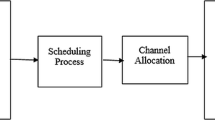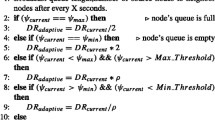Abstract
This paper proposes urgency-based packet scheduling and routing algorithms to effectively deliver delay-sensitive data over a multi-hop mobile ad hoc networks supporting IEEE 802.11 multi-rate service. First, packet urgency, node urgency, and route urgency are defined on the basis of the end-to-end delay requirement. Based on these urgency metrics and the estimated transmission delay of each packet by Kalman filter, the proposed packet scheduling algorithm determines the transmission order and drop policy to minimize the node urgency without unnecessary packet drop, and the proposed routing algorithm establishes a route to minimize the derivative of route urgency in order to maximize the number of packets delivered within the required end-to-end delay. Finally, experimental results are presented to evaluate the performance of the proposed joint working algorithms.
















Similar content being viewed by others
References
Lindeberg, M., Kristiansen, S., Plagemann, T., & Goebel, V. (2011). Challenges and techniques for video streaming over mobile ad hoc networks. Springer Multimedia Systems, 17(1), 51–82.
Calafate, C. T., Malumbres, M. P., Oliver, J., Cano, J. C., & Manzoni, P. (2009). QoS support in MANETs: A modular architecture based on the IEEE 802.11e Technology. IEEE Transactions on Circuits and Systems for Video Technology, 19(5), 678–692.
Perkins, C. E., & Bhagwat, P. (1994). Highly dynamic destination-sequenced distance-vector routing (DSDV) for mobile computers. ACM SIGCOMM Computer Communication Review, 24(4), 234–244.
Clausen, T., Jacquet, P., Laouiti, A., Minet, P., Muhlethaler, P., Qayyum, A. & Viennot, L. (2002). Optimized link state routing protocol. IETF Internet Draft, draft-ietf-manet-olsr-07.txt.
Chiang, C. C., Wu, H. K., Liu, W., & Gerla, M. (1997). Routing in clustered multihop mobile wireless networks with fading channel. IEEE Singapore International Conference on Networks (SICON) (pp. 197–211), Apr 1997.
Murthy, S., & Garcia-Luna-Aceves, J. J. (1996). An efficient routing protocol for wireless networks. ACM/Baltzer Mobile Networks and Applications, 1(2), 183–197.
Johnson, D. B., Maltz, D. A., & Broch, J. (2001). DSR: The dynamic source routing protocol for multi-hop wireless ad hoc networks in ad hoc networking (pp. 139–172). Reading: Addison-Wesley.
Perkins, C., Belding-Royer, E., & Das, S. (2002). Ad hoc on-demand distance vector (AODV) Routing. IETF RFC 3561, July 2002.
Park, V. D. & Corson, M. S. (1997) A highly adaptive distributed routing algorithm for mobile wireless networks. IEEE International Conference on Computer Communications (INFOCOM), Apr. 1997.
Jiang, M., Li, J., & Tay, Y. C. (1999). Cluster Based Routing Protocol (CBRP). IETF MANET Working Group, Internet-Draft.
Pearlman, M. R., & Hass, Z. J. (1999). Determining the optimal configuration for the zone routing protocol. IEEE Journal on Selected Areas in Communications, 17(8), 1395–1414.
Chen, T., Walrand, J., & Messerschmitt, D. (1989). Dynamic priority protocols for packet voice. IEEE Journal on Selected Areas in Communications, 7(5), 632–643.
Li, C., & Knightly, E. (2002). Coordinated multihop scheduling: A framework for end-to-end services. IEEE/ACM Transactions on Networking, 10(6), 776–789.
Lim, H., Lim, C., & Hou, J. C. (2006). A coordinate-based approach for exploiting temporal-spatial diversity in wireless mesh networks. ACM International Conference on Mobile Computing and Networking (MobiCom) (pp. 14–25), Sep. 2006.
Iannaccone, G., Brandauer, C., Ziegler, T., Diot, C., Fdida, S., & May, M. (2001). Comparison of tail drop and active buffer management performance for bulk-data and web-like internet traffic. IEEE Symposium on Computers and Communications (ISCC) (pp. 122–129), July 2001.
Floyd, S., & Jacobson, V. (1993). Random early detection gateways for congestion avoidance. IEEE/ACM Transaction on Networking, 1(4), 397–413.
Feng, W., Shin, K. G., Kandlur, D., & Saha, D. (2002). The BLUE active buffer management algorithms. IEEE/ACM Transactions on Networking, 10(4), 513–528.
Ott, T. J., Lakshman, T. V., & Wong, L. H. (1999). SRED: Stabilized RED. IEEE International Conference on Computer Communications (INFOCOM) (pp. 1346–1355), Mar. 1999.
Aweya, J., Ouellette, M., Montuno, D. Y., & Chapman, A. (2001). A control theoretic approach to active buffer management. Computer Networks, 36, 203–235.
Elbatt, T. & Ephremides, A. (2002). Joint scheduling and power control for wireless ad-hoc networks. IEEE International Conference on Computer Communications (INFOCOM) (pp. 976–984).
Chen, L., & Heinzelman, W. (2005). QoS-aware routing based on bandwidth estimation for mobile ad hoc networks. IEEE Journal on Selected Areas in Communications, 23(3), 561–572.
Liang, B., & Dong, M. (2007). Packet prioritization in multi-hop latency aware scheduling for delay constrained communication. IEEE Journal on Selected Areas in Communications, 25(4), 819–830.
Wu, H., Wang, X., Liu, Y., Zhang, Q., & Zhang, Z. (2005). SoftMAC: Layer 2.5 MAC for VoIP support in multi-hop wireless networks. IEEE Communications Society Conference on Sensor, Mesh and Ad Hoc Communications and Networks (SECON), Sep. 2005.
Holland, G., Vaidya, N., & Bahl, P. (2001). A rate-adaptive mac protocol for multi-hop wireless networks. ACM International Conference on Mobile Computing and Networking (MobiCom), July 2001.
Sadeghi, B., Kanodia, V., Sabharwal, A., & Knightly, E. (2002). OAR: An opportunistic auto-rate media access protocol for ad hoc networks. ACM International Conference on Mobile Computing and Networking (MobiCom), Sep. 2002.
Ji, Z., Yang, Y., Zhou, J., Takai, M., & Bagrodia, R. (2004). Exploiting medium access diversity in rate adaptive wireless LANs. ACM International Conference on Mobile Computing and Networking (MobiCom) (pp. 345–359), Sep. 2004.
Seok, Y., Park, J., & Choi, Y. (2003). Multi-rate aware routing protocol for mobile ad hoc networks. In IEEE Vehicular Technology Conference (pp. 1749–1752). Spring 2003.
Fan, Z. (2004). High throughput reactive routing in multi-rate ad hoc networks. Electronics Letters, 40(25), 1591–1592.
Ryu, S., Ryu, B., Seo, H., & Shin, M. (2005). Urgency and efficiency based packet scheduling algorithm for OFDMA wireless system. IEEE International Conference on Communications (ICC) (pp. 2779–2785), May 2005.
Huang, L. & Lai, T. H. (2002). On the scalability of IEEE 802.11 ad hoc networks. ACM International Symposium on Mobile Ad Hoc Networking & Computing, Lausanne, Switzerland (pp. 173–182). June 2002.
Lai, T. H. & Zhou, D. (2003). Efficient and scalable IEEE 802.11 ad-hoc-mode timing synchronization function. International Conference on Advanced Information Networking and Applications (pp. 318–323), Mar. 2003.
Sheu, J. P., Chao, C. M., Hu, W. K., & Sun, C. W. (2007). A clock synchronization algorithm for multihop wireless ad hoc. Wireless Personal Communications, 43(2), 185–200.
Holland, G., Vaidya, N., & Bahl, P. (2001). A rate-adaptive MAC protocol for multi-hop wireless networks. International Conference on Mobile Computing and Networking (pp. 236–251), Aug. 2001.
Bianchi, G. & Tinnirello, I. (2003). Kalman filter estimation of the number of competing terminals in an IEEE 802.11 network. Annual Joint Conference of the IEEE Computer and Communications (pp. 844–852), Apr. 2003.
Ekelin, S., Nilsson, M., Hartikainen, E., Johnsson, A., Mangs, J. E., Melander, B., & Bjorkman, M. (2006). Realtime measurement of end-to-end available bandwidth using Kalman filtering. IEEE/IFIP Network Operations and Management Symposium (NOMS) (pp. 73–84), Apr. 2006.
Carvalho, M. M., Garcia-Luna-Aceves, J. J. (2003). Delay analysis IEEE 802.11 in single-hop networks. IEEE International Conference on Network Protocols, Atlanta, GA, USA, Nov. 2003.
NS-2 [Online]. Available: http://www.isi.edu/nsnam/ns/index.html/.
IEEE 802.11b (1999). Part 11: Wireless LAN Medium Access Control (MAC) and Physical Layer (PHY) specifications: Higher Speed Physical Layer Extension in the 2.4 GHz Band.
Joint Video Team (JVT) reference software, version 15.1. [Online]. Available: http://iphome.hhi.de/suehring/tml/.
Acknowledgments
This research is supported by the MKE (The Ministry of Knowledge Economy), Korea, under the HNRC (Home Network Research Center)—ITRC (Information Technology Research Center) support program supervised by the NIPA (National IT Industry Promotion Agency) (NIPA-2011-C1090-1111-0010) and World Class University program funded by the Ministry of Education, Science and Technology through the National Research Foundation of Korea (R31-10100).
Author information
Authors and Affiliations
Corresponding author
Rights and permissions
About this article
Cite this article
Kim, W., Joo, H., An, K.J. et al. Urgency-based packet scheduling and routing algorithms for delay-sensitive data over MANETs. Wireless Netw 19, 1595–1609 (2013). https://doi.org/10.1007/s11276-013-0557-1
Published:
Issue Date:
DOI: https://doi.org/10.1007/s11276-013-0557-1




